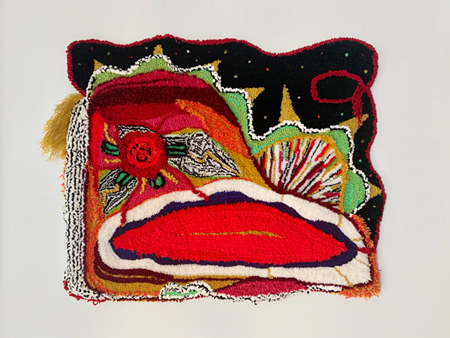Unartisanal ||
Back to exhibition
Ana Maria Farina
What draws you to the materials you work with?
I love yarn. I love working with it, touching it and creating surfaces that can provide a sense of comfort.
Why "craft" and not "art"?
I don't choose one over another; I believe these are closely intertwined. My process is craft--based, meaning I use craft techniques and hours of focus and labor to create. However I do consider my end product to be art, since I am not creating something simply utilitarian but instead using these methods as a means for expression and investigation. At the same time, I question the marginalization of the category of craft and how much of that is due to it being related to a majorly feminine and a lot of times non-white practice.
In what ways are you expanding upon the realm of craft?
I am making use of these techniques, some of them passed through generations in my family, to investigate questions about the worlds we inhabit.
Is your work rooted in any specific traditions or techniques?
Right now my main technique is tufting, a carpet--making process. I also use latch hooking, punch needle (which in Brazil is curiously called Russian stitch) and rug hooking.
How do you navigate "craft" while avoiding popular trends?
I think as long as your work speaks to you and your practice is genuine and related to your research/life interests, then there are no such things as trends.
Do you consider craft utilitarian, or decorative, or both/neither? Why?
It depends. I consider craft as a process. What the artist will do with it will tell. For instance, I believe figurative painting to be intensely craft--based. Now the product could be considered craft/commercial or it could be fine art, depending on the intention of the artist.
Why do you think so many people are returning to fiber arts these days?
I know I returned to fibers as a way to return home, in both the sense of the home within, to feel grounded, and my ancestral home, to feel connected to my roots. There's also the fact that everything is so incredibly fast and ephemeral, and fiber work requires the complete opposite. You can't rush it. You have to sit there for hours and hours and work every stitch.
How has the pandemic affected your practice?
Well I'm privileged enough that I could still find space in my living room to continue to work. But one thing that I realized that was super important is that I absolutely love working from home. It was the first time I did it (since I've always lived in tiny spaces and had studio spaces somewhere else) and it felt great. Like the work can be a part of your routine so organically like any other thing you do in your day. And you can come back to it whenever you feel like it. It lives with you, and that relationship is important to me.
Unartisanal is funded in part by the New York State Council on the Arts and the
New York City Department of Cultural Affairs
Unartisanal ||
Back to exhibition

